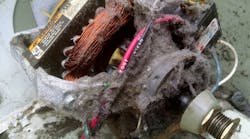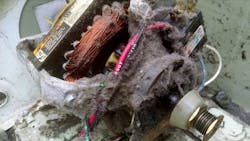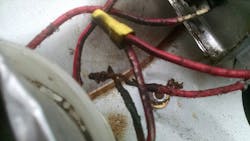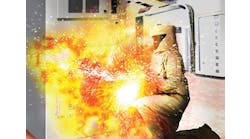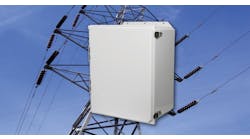There I was driving along a side road when I saw this hunk of scrap metal out at the curb. We all know that these days free metal, especially when organized, is a good way to pick up some extra cash. So I stopped and tossed this well-used electric dryer into the back of my pick-up and continued on my way home.
I decided to dissect it, grab some copper and aluminum from it, and before long parts were scattered all over my garage floor. It was then that I saw why it had been discarded in the first place — and why I decided to share what I found with my fellow electricians, firefighters, and investigators.
Most people have seen and used an electric dryer. Some of us even understand the inner workings of the machines. But let’s take a look at how they work as a refresher.
Once loaded up with wet clothes, users set the dial for how much heat they want, push the button, and then this magic machine dries the clothes and makes the electric meter outside spin really fast.
The truth is, the inner workings of the dryer are pretty much as simple as the outside. There is a metal drum that you load the clothes into, which is turned by a motor via a thin belt. A heating coil provides the hot air, which gets blown into the drum. An exhaust duct takes the heated air and the lint and blows it out of the dryer, hopefully into a properly ducted system vented to the outside of the structure. To prevent overheating of the coils, there are two thermal limiting switches located near the heat coils. These will break the circuit should the temperature become too hot for the system. All of this is packaged neatly into a sheet metal enclosure marked with a UL symbol, which assures us that this is a “listed” assembly right out of the box.
Now let’s take a more in depth look at what the components include and how they are rated. The connections are metal crimp spade terminals without the plastic insulation on them. These terminals (depending on brand) have a listed rating of 105°C, as do the machine tool wire (MTW) insulated conductors used between them.
The first thermal limiter is a thermostat that is set for 250°F. This turns the elements on and off during use and maintains the temperature during the timing cycle. The second is a thermal fuse set at 352°F, which shuts the machine down to prevent a fire. The heating coil itself has the potential to provide 7,200W (240V × 30A = 7,200W); however, it is rated at 5,400W. What does this all mean?
Your wire and terminations are listed at 105°C or 221°F and are below the temperature rating of the over-temp protective devices. Now before you start calling UL, keep in mind that these are located in separate compartments (although they are very close together). In a new or well-maintained dryer that is properly vented, this isn’t a problem at all. It’s kind of like not putting your fingers in the toaster while it’s making toast.
But other elements are in play here that include lint buildup, selected drying temperature, type and length of vent, as well as the number of bends in the exhaust pipe. Of course, the biggest factor in the equation is: Did someone tamper with or attempt to fix this dryer? This brings me back around to my autopsy of this particular machine.
Once I removed the sheet metal panels from the rear compartment, I discovered a large buildup of lint, some burned up conductors, and a twist-on wire connector holding them together.
Now the picture is starting to become clearer. At some point, a connection in the dryer undoubtedly failed. Someone, who obviously “fixed” the problem by making that splice, became the hero when the dryer came back on again! However, what he or she didn’t think about was the connector — although rated for 105°C (depending on manufacturer) — could exceed its rated temperature. In this case, it did, which caused the plastic to melt. In turn, the connection failed and ignited the lint surrounding the splice. Add to that the fact that the UL listing of the machine has been violated, and someone is definitely to blame here.
If an investigator had discovered this, fingers would start to be pointed at who fixed the dryer. Was it a handyman, homeowner, previous homeowner, or was it you (the electrician) helping your customer? If the fire that undoubtedly ensued was contained to room and contents, you might have gotten lucky. However, if injuries or deaths occurred, that’s a whole different story.
Why is this important to us? A 1998 U.S. Consumer Product Safety Commission report noted that dryer fires account for 15,000 fires every year. For more information, go to www.cpsc.gov/PageFiles/117075/dryer.pdf, and read the full report. As noted in the NFPA U.S. Home Product Report, Appliances & Equipment, November 2005, dryer fires account for 4% of reported fires each year.
Although electricians are all capable of fixing these types of little failures, it’s best to step way back and look at the bigger picture. Don’t “own” someone else’s problem, but do recommend a regularly scheduled maintenance program to your customers or potential clients. Tell them to periodically inspect, vacuum, and clean the dryer (gas models too) — and inspect the dryer vent to make sure that it is installed and working properly per code.
Kostick is a licensed master electrician in New Jersey and Delaware and has worked in the industry for 37 years. He is also a licensed electrical instructor in New Jersey and a certified fire instructor. He can be reached at [email protected].
